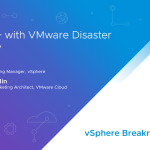VMware’s Site Recovery Manager product has a number of
interesting features that enable a whole new way to look at disaster recovery
and business continuity. One that
we are going to look at today is the test failover, and more specifically at
the network possibilities around the test failover.
It is important during a test failover to test your virtual
machines without them being visible to the production systems. Things like IP and name conflicts can
happen if you are not careful and they will ruin your day. So isolating those VM’s is important
but we need to do that in a way that we can still properly test.
If you have only one ESX server you can use the
automatically generated test bubble network that connects the VM’s
together. This private virtual
switch will allow VM’s to talk to each other without the traffic leaving that
switch. So we are preserving the
important isolation. This is the
default for a recovery plan. It is
shown as Auto in the Test Network column when you edit the Network part of a
recovery plan. You can see this in
the screen shot below. You can
learn more about this on page 62 of the Admin Guide – URL for it is below.
When you have multiple hosts, and you need VM’s on each of
the hosts to communicate with each other we cannot use the private virtual
switch method as it has too much isolation (it does not span hosts). The solution to that is to use an
isolated VLAN. This VLAN will be
connected to a virtual switch that can be specified in the same place that Auto
is. You can see this in the figure
below. In this example when a test
failover occurs, and a VM is connected normally to the CorporateLAN virtual
switch, it will be connected to the CRM Test Network virtual switch during the
failover. With the
isolated VLAN connected to that virtual switch on each host, your VM’s will now
all be able to communicate.
While we may now have a connection among the virtual
machines, it may not be completely usable. You may need to have services such as AD domain controllers,
or even things like DNS / DHCP that today’s corporate networks cannot live
without. According to best
practices these services exist at the recovery site, so in a real failover they
will be there for you to use. But
in this test failover they are not available so you need to include them on the
isolated VLAN. This is not hard to
do when everything is virtual because we support manual or scripted hot cloning,
but if your infrastructure services are not yet virtualized you can use
Converter as a great way to move your physical servers into the virtualized
world. You can clone your AD domain
controllers and your DNS / DHCP machines and put them on that isolated VLAN.
While it is a little more work, I would recommend deleting these clones after
the end of your test failover and creating them new when you need them
again. If you are good with AD /
DHCP / DNS than you can just return them to the corporate network by changing
their virtual switch. It is
important to keep these infrastructure machines current so they need to
communicate outside the isolated VLAN at times. Current means things like passwords, DNS names and IP
addresses. If your DNS / DHCP
servers stay on the isolated VLAN you may not be able to resolve names or IP’s
as you do on your corporate network.
However AD domain controllers will eventually have serious problems (and
become useless) if they do not see their peers on a regular basis.
This is the Network section that you can see when
editing a Recovery Plan
So we now have a private isolated network between VM’s on a
variety of hosts. We have services
like DNS / DHCP on that same isolated network. But now we need to provide access to people to do testing. While this can be done via the Virtual
Infrastructure Client, that is often not the best way. It requires resources beyond what an
RDP or VNC connection direct to the VM requires, and best practices for
VirtualCenter suggest less than 20 connections to VC at one time.
There are several suggestions that can help with this access
issue. You can have PC’s that are
connected directly to the isolated VLAN.
I have set this up in shared workspaces like coffee rooms and
classrooms. People are able to
work as they expect due to the shared infrastructure services in the isolated
VLAN like AD or DNS. Another
example, and my favorite is to have one or more VDI servers that have access to
the isolated VLAN and then users can connect from their own desk using a
browser to the VDI server and have access to a desktop VM on the inside of that
isolated VLAN. This requires the
VDI server to have two network cards – one for the isolated VLAN, and one for
the corporate network. This VDI
server is NOT a router so it will not break the important isolation rule.
So we now have an isolated VLAN with infrastructure
services, VM’s from a variety of hosts, and even have users accessing those
VM’s, and with no chance of our testing touching the corporate assets that they
mirror.
SRM is groundbreaking workflow software that like our
products before it really highlights how virtualization truly enables IT and I
think that this test failover networking I wrote about here lives up to it!
Isn’t virtualization wonderful!
More Information?
SRM Administration Guide – http://www.vmware.com/pdf/srm_10_admin.pdf
Virtual Switch info – ESX Server Configuration Guide – http://www.vmware.com/pdf/vi3_35/esx_3/r35u2/vi3_35_25_u2_3_server_config.pdf
SRM 1.0 Update 1 Release Notes – http://www.vmware.com/support/srm/srm_10_releasenotes.html
SRM Community Forum – http://communities.vmware.com/community/vmtn/mgmt/srm?view=discussions
VMware Converter product page – http://www.vmware.com/products/converter/
VMware SRM product page – http://www.vmware.com/products/srm/
If I can ask a small favor? Please let us know what you think of this article and blog by leaving comments. If there is something you would like us to write about please do not hesitate to leave a comment about that! Thanks for helping.
Michael
==== END ===















